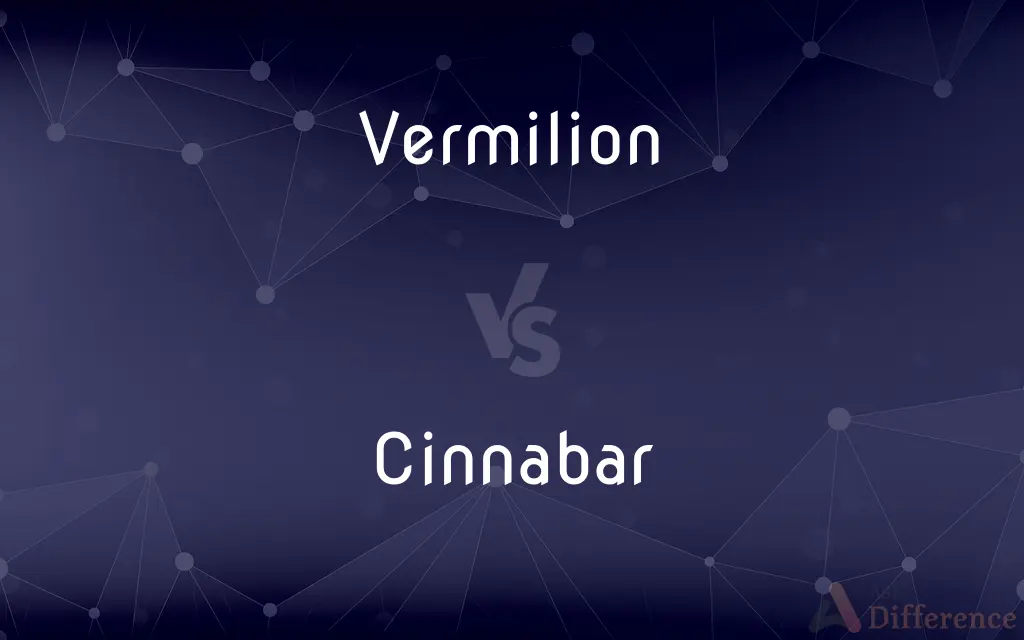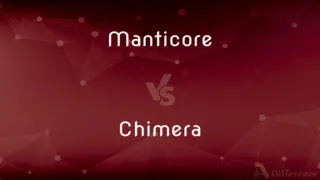Vermilion vs. Cinnabar — What's the Difference?
By Maham Liaqat & Fiza Rafique — Updated on March 28, 2024
Vermilion is a brilliant red pigment made from mercury sulfide, while cinnabar refers to the naturally occurring mineral form of this compound.

Difference Between Vermilion and Cinnabar
Table of Contents
ADVERTISEMENT
Key Differences
Vermilion is a synthetic pigment used in art and decoration for its vivid red color, made by grinding natural cinnabar or synthesizing mercury sulfide. Whereas cinnabar is the mineral form, mined for its mercury content and used historically as a pigment.
Vermilion, due to its synthetic production, has been widely used in paintings and coatings, offering consistency in hue and texture. On the other hand, cinnabar, being a naturally occurring mineral, varies in purity and shade, making each batch unique.
While vermilion pigments are praised for their bright, scarlet hue in artworks, cinnabar's appeal lies in its natural form, often used in jewelry and carvings.
The toxicity of mercury in both vermilion and cinnabar has led to safer alternatives in pigments, yet they remain subjects of interest for their historical and artistic significance.
Vermilion's role in cultural and religious artworks underscores its importance across civilizations, whereas cinnabar's value extends to its use in traditional medicine and ornamental objects.
ADVERTISEMENT
Comparison Chart
Composition
Synthetic mercury sulfide (HgS)
Natural mercury sulfide (HgS)
Use
Pigment in paints and art
Ore for mercury extraction, pigment
Color Consistency
Uniform, vivid red
Varies depending on purity
Historical Significance
Used in art and decoration across cultures
Used in ancient artifacts, jewelry
Health and Safety Concerns
Highly toxic, less used today
Highly toxic, mined for mercury extraction
Compare with Definitions
Vermilion
A brilliant red or scarlet pigment made from mercury sulfide.
Artists valued vermilion for its bright hue in Renaissance paintings.
Cinnabar
A mineral composed of mercury sulfide, known for its vibrant red color.
Cinnabar has been mined for thousands of years for both its mercury content and pigment.
Vermilion
Manufactured by combining sulfur and mercury.
The synthetic process of vermilion involves careful handling due to toxicity.
Cinnabar
Carved into ornaments and jewelry.
Ancient civilizations prized cinnabar carvings for decorative purposes.
Vermilion
Commonly used in paintings for its vivid red color.
Vermilion was often chosen for its striking impact in historical artworks.
Cinnabar
Found in areas with volcanic activity and hot springs.
Significant cinnabar deposits are often located near volcanic regions.
Vermilion
Symbolizes life and eternity in some cultures.
In Chinese culture, vermilion is used in temple doors for its auspicious significance.
Cinnabar
Historically used in traditional medicine.
Traditional practitioners used cinnabar despite its toxic properties.
Vermilion
Contains mercury, making it toxic to use without precautions.
Despite its beauty, vermilion's use has declined due to health concerns.
Cinnabar
High mercury content poses environmental and health risks.
The extraction and use of cinnabar are regulated due to mercury hazards.
Vermilion
Vermilion (sometimes spelled vermillion) is both a brilliant red or scarlet pigment, originally made from the powdered mineral cinnabar, and the corresponding color. It is commonly used in Hindu culture, primarily by women, and was widely used in the art and decoration of Ancient Rome, in the illuminated manuscripts of the Middle Ages, in the paintings of the Renaissance, and in the art and lacquerware of China.
Cinnabar
Cinnabar () or cinnabarite (), from the Ancient Greek: κιννάβαρι (kinnabari), is the bright scarlet to brick-red form of mercury(II) sulfide (HgS). It is the most common source ore for refining elemental mercury, and is the historic source for the brilliant red or scarlet pigment termed vermilion and associated red mercury pigments.
Vermilion
A brilliant red pigment made from mercury sulphide (cinnabar).
Cinnabar
A heavy reddish mercuric sulfide, HgS, that is the principal ore of mercury.
Vermilion
A vivid red to reddish orange. Also called Chinese red, cinnabar.
Cinnabar
See mercuric sulfide.
Vermilion
See mercuric sulfide.
Cinnabar
See vermilion.
Vermilion
Of a vivid red to reddish orange.
Cinnabar
A deep red mineral, mercuric sulfide, HgS; the principal ore of mercury; such ore used as the pigment vermilion.
Vermilion
To color or dye (something) in the hue vermilion.
Cinnabar
A bright red colour tinted with orange.
Vermilion
A vivid red synthetic pigment made of mercury sulfide, cinnabar.
Cinnabar
(countable) A species of moth, Tyria jacobaeae, having red patches on its predominantly black wings.
Vermilion
A bright orange-red colour.
Cinnabar
The Elixir of Life.
Vermilion
A type of red dye worn in the parting of the hair by married Hindu women.
Cinnabar
Of a bright red colour tinted with orange.
Vermilion
The red skin of the lips or its border with the skin of the face.
Cinnabar
Red sulphide of mercury, occurring in brilliant red crystals, and also in red or brown amorphous masses. It is used in medicine.
Vermilion
(obsolete) The kermes or cochineal insect.
Cinnabar
The artificial red sulphide of mercury used as a pigment; vermilion.
Vermilion
(obsolete) The cochineal dye made from this insect.
Cinnabar
A heavy reddish mineral consisting of mercuric sulfide; the chief source of mercury
Vermilion
Having a brilliant red colour.
Cinnabar
Large red-and-black European moth; larvae feed on leaves of ragwort; introduced into United States to control ragwort
Vermilion
Having the color of the vermilion dye.
Cinnabar
Of a vivid red to reddish-orange color
Vermilion
(transitive) To color or paint vermilion.
Vermilion
A bright red pigment consisting of mercuric sulphide, obtained either from the mineral cinnabar or artificially. It has a fine red color, and is much used in coloring sealing wax, in printing, etc.
Vermilion
Hence, a red color like the pigment; a lively and brilliant red; as, cheeks of vermilion.
Vermilion
To color with vermilion, or as if with vermilion; to dye red; to cover with a delicate red.
Vermilion
A variable color that is vivid red but sometimes with an orange tinge
Vermilion
Color vermilion
Vermilion
Of a vivid red to reddish-orange color
Common Curiosities
What is vermilion used for?
Vermilion is used as a pigment in art and decorations for its vivid red color.
How is cinnabar different from vermilion?
Cinnabar is the natural mineral form of mercury sulfide, while vermilion is the synthetic pigment form.
Are vermilion and cinnabar safe to handle?
Both contain mercury, making them toxic and unsafe to handle without precautions.
Do vermilion and cinnabar have cultural significance?
Yes, both have been used in various cultures for artistic, medicinal, and spiritual purposes.
Is cinnabar still mined today?
Yes, primarily for mercury extraction, but its use as a pigment is less common.
How are vermilion and cinnabar made?
Vermilion is synthesized from mercury and sulfur, whereas cinnabar occurs naturally.
What are the main uses of vermilion and cinnabar today?
Vermilion is used in restoration and artistic projects, while cinnabar is valued in jewelry and collectibles.
What are the safety concerns with using cinnabar?
Its mercury content poses significant health and environmental risks.
Can vermilion and cinnabar be used interchangeably in art?
While both offer a red pigment, their properties and safety concerns differ, making them not fully interchangeable.
Can cinnabar be used in art?
Yes, cinnabar has been historically used as a pigment in art, though its use has declined due to toxicity concerns.
Why is vermilion considered important in historical paintings?
Its bright red color offered artists a vivid hue that symbolized life and passion.
What historical civilizations used cinnabar?
Civilizations such as the Chinese, Mayans, and Romans used cinnabar for various purposes.
Has the use of vermilion changed over time?
Yes, due to its toxicity, safer alternatives have largely replaced it.
Is there a non-toxic alternative to vermilion and cinnabar?
Modern pigments and dyes offer non-toxic red hues, reducing the reliance on these materials.
Why is cinnabar valued in jewelry?
Its vibrant red color and rarity make it a prized material for decorative items.
Share Your Discovery

Previous Comparison
Manticore vs. Chimera
Next Comparison
Agent vs. SpyAuthor Spotlight
Written by
Maham LiaqatCo-written by
Fiza RafiqueFiza Rafique is a skilled content writer at AskDifference.com, where she meticulously refines and enhances written pieces. Drawing from her vast editorial expertise, Fiza ensures clarity, accuracy, and precision in every article. Passionate about language, she continually seeks to elevate the quality of content for readers worldwide.














































